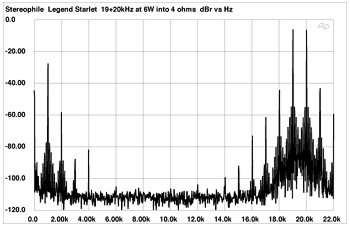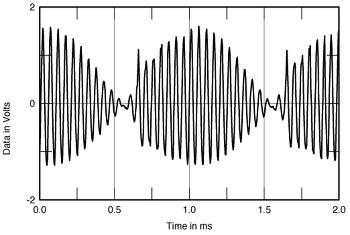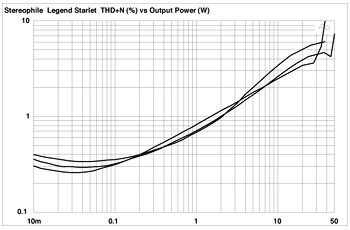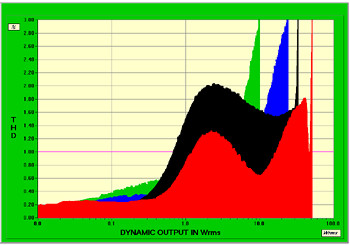| Columns Retired Columns & Blogs |
Legend Audio Design Starlet integrated amplifier Measurements part 3
Second-harmonic distortion is surprisingly euphonic; the ear can tolerate reasonably high levels of it, due to psychoacoustic masking and the fact that the second harmonic has a musically consonant octave relationship with the fundamental tone. But the same bent transfer function that gives rise to the harmonic distortion, if too bent will also produce high levels of intermodulation distortion, which is subjectively far more damaging to music. Fig.7 shows the spectrum of the Starlet's output while it struggles to reproduce a 1:1 mix of 19 and 20kHz tones at an indicated 6W into 4 ohms, just below visible clipping with this demanding signal. The 1kHz difference product lies at -27.6dB, which is around a very audible 4%. And again, you can see power-supply-related sidebands around each of the spectral tones.

Fig.7 Legend Starlet, HF intermodulation spectrum, DC-22kHz, 19+20kHz at 6W into 4 ohms (linear frequency scale).
Out of morbid curiosity, I captured the waveform of this signal (fig.8). The 19 and 20kHz tones sum to produce a combined waveform with a peak amplitude twice that of either wave on its own, and the waveform's envelope is modulated at a frequency of 1kHz. (Because the 1kHz modulation affects only the envelope of the waveform, there should be no actual 1kHz content in the amplifier's output.) As I hope you can still see at the scale at which this graph must be reproduced in the magazine, the waveform as output by the Starlet is severely asymmetrical, its positive-going half being significantly larger than its negative half. Whenever you see such asymmetry, there will always be even-harmonic content, which is actually more typical of a single-ended design than the push-pull Legend. (Perfect push-pull operation cancels even harmonics by ensuring signal symmetry.)

Fig.8 Legend Starlet, HF twin-tone waveform from fig.7.
Finally, I examined how the Starlet's distortion varied with output power, both with continuous 1kHz tones with both channels driven (fig.9) and with a low-duty-cycle 1kHz toneburst and only one channel driven (fig.10). In either case, the Legend amplifier's output at the usual 1% THD+N point is laughably low: between 1W and 2W! Relaxing the definition of clipping to 3% THD+N gives figures closer to the manufacturer's specification, especially under toneburst conditions—33.5W into 8 ohms (15.25dBW), 52W into 4 ohms (14.2dBW), with a maximum current of 3.2A RMS—but this is clearly very nonlinear amplifier design.

Fig.9 Legend Starlet, distortion (%) vs continuous output power into (from bottom to top at 2kHz): 8 ohms, 4 ohms, and 2 ohms (both channels driven).

Fig.10 Legend Starlet, distortion (%) vs 1kHz burst output power into 8 ohms (black trace), 4 ohms (red), 2 ohms (blue), and 1 ohm (green).
Or is it? Early on in the measurements, I became suspicious of the active preamp stage and made sure I used small input signals with the volume control full up, even though this maximized the contribution of the hum. And yes, when I specifically checked the effect of the volume control after I had finished the usual set of measurements, it turned out that the Starlet's active preamp stage is actually a distortion generator: The smaller the input signal and the higher the volume-control setting, the less distortion is produced. (Both channels behaved identically, so I assumed this is probably not due to something being broken. However, Legend later claimed that a preamplifier tube was not working properly—see their "Manufacturer's Comment" letter.) With the volume control set to 2:00, an input level of 100mV had 0.4% of added distortion—this is acceptable, given the strong second-harmonic nature of the distortion. But when the input level was increased to 1V and the volume control backed off to give the same output level, the distortion increased to 1%. And when I fed the amplifier with 2V (the typical maximum output of a CD player), and backed off the volume control even further, again to keep the output level constant, the distortion was a distressingly high 6.6%!
The test conditions for figs.9 and 10 involve keeping the volume-control setting constant and driving the amplifier with increasing input levels. But with what appears to be a saturating preamp section, the Starlet's graphs are actually dominated by the preamp's nonlinearity, at least until the hard-clipping point. I therefore suspect that the Starlet's power-amplifier section is actually more linear than this set of measurements suggests. But add a variable distortion generator in front of that power amp—Chip was correct to call it a "tone machine"—and the result is anybody's guess. With a high-level source like CD, each musical peak will be accompanied by bursts of extreme second-harmonic and intermodulation distortion that might sound "right" and even compensate under some circumstances for the prematurely rolled-off top octave, but will ultimately be fatiguing. In my opinion.—John Atkinson
- Log in or register to post comments




































